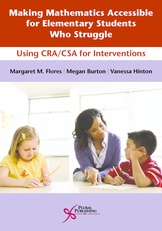Publication
Making Mathematics Accessible for Elementary Students Who Struggle
Using CRA/CSA for Interventions
- Details:
- 280 pages, Illustrated (B/W), Softcover, 7 x 10"
- ISBN13:
- 978-1-59756-984-2
- Release Date:
- 07/31/2017
Overview
Making Mathematics Accessible for Elementary Students Who Struggle: Using CRA/CSA for Interventions provides educators with focused methods for students who struggle in elementary mathematics. The methods and procedures revolve around the CRA/CSA (concrete-representational/semi-concrete-abstract) instructional sequence. These strategies are intended for small group intensive instruction, one that addresses students' need for increased repetition and explicitness that cannot be provided within a large group of students with diverse learning needs.
Current research on the CRA/CSA instructional sequence is scattered across multiple resources. This book provides comprehensive coverage of the most up-to-date research in one user-friendly resource. The sequence is included in every chapter and addresses instruction related to number sense, counting, basic operations, complex operations, basic fraction concepts, and operations with fractions.
This resource is written by experienced professors spanning the fields of special education and curriculum and teaching. Its professional insight, aligned with current mathematical teaching standards and CRA/CSA research, makes this text invaluable to upcoming or current teachers in elementary mathematics.
Key Features:
- Explicit and hands-on examples of CRA/CSA's use aligned with current mathematics standards and practices
- Suggestions and tips for various classroom situations
- Application questions for every chapter
- Drawings and diagrams associated with steps of the teaching process
- Classroom-tested strategies
Preface
Chapter 1. Purpose
Chapter 2. Number Sense and the Concrete-Representational/Semi-Concrete-Abstract Sequence
Chapter 3. Counting, Cardinality, and the Concrete-Representational/Semi-Concrete-Abstract Sequence
Chapter 4. Teaching Addition Using the Concrete-Representational/Semi-Concrete-Abstract Sequence
Chapter 5. Teaching Subtraction Using the Concrete-Representational/Semi-Concrete-Abstract Sequence
Chapter 6. Teaching Multiplication Using the Concrete-Representational/Semi-Concrete-Abstract Sequence
Chapter 7. Teaching Division Using the Concrete-Representational/Semi-Concrete-Abstract Sequence
Chapter 8. Understanding Fractions Using the Concrete-Representational/Semi-Concrete-Abstract Sequence
Chapter 9. Operations with Fractions Using the Concrete-Representational/Semi-Concrete-Abstract Sequence
Index
About The Authors
Margaret M. Flores, PhD, BCBA-D was a special education teacher in the public schools before earning her doctorate in Education of Students with Exceptionalities from Georgia State University. She is currently a Professor at Auburn University in the Department of Special Education, Rehabilitation, and Counseling. Her research interests include mathematics interventions for students with disabilities and students receiving tiered interventions. The majority of her research in mathematics interventions includes implementation of the concrete-representational/semi-concrete-abstract sequence.
Megan Burton, PhD was a classroom teacher in grades 1-4 in the public schools before earning her doctorate in Elementary Education with a focus on Mathematics Education at the University of Alabama. Much of her classroom experience was as a teacher in inclusion classrooms. She is currently an Associate Professor and Elementary Education Program Coordinator at Auburn University in the Department of Curriculum and Teaching, Her research interests include teacher identities, knowledge and perceptions in mathematics and rural education. This includes teachers involved in interventions for students with disabilities and students receiving tiered interventions.
Vanessa Hinton, PhD is an Assistant Clinical Professor at Auburn University. Before working at the university, she taught special education for eleven years. Her research interests include tiered instruction for mathematics and supports for students with disabilities.
Related Titles
Educating Students with Autism Spectrum Disorder
Joshua K. Harrower, Louis G. Denti, Marcia Weber-Olsen
245 pages, Illustrated (B/W), Softcover, 7 x 10"
Computer-Based Technology for Special and Multicultural Education
Edited by: Lenwood Gibson, Festus Obiakor
325 pages, Illustrated (B/W), Softcover, 6 x 9"
Improving Educational Outcomes of Vulnerable Children
Floyd D. Beachum, Festus Obiakor
287 pages, Illustrated (B/W), Softcover, 6 x 9"
Educating Latino Preschool Children
232 pages, Illustrated (B/W), Softcover, 6 x 9"











